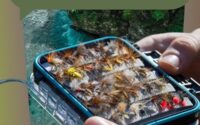| Disclosure: Just to be open and honest the buttons and links you click on in the website will in most cases take you to another website where you can purchase the products I am reviewing. As an Amazon Associate I earn from qualifying purchases. |
Casting into Adventure: The Guide to Fly Fishing Success
Quick Post Navigation
Introduction to Fly Fishing
Fly fishing is not just a hobby; it’s a passion for many outdoor enthusiasts. Unlike conventional fishing methods, fly fishing involves using a lightweight lure or “fly” to catch fish. But does this method really yield more catches? Let’s delve into the nuances of fly fishing and find out.
Understanding Fly Fishing Basics
Equipment Needed for Fly Fishing
When it comes to fly fishing, having the right gear is essential. This includes a specialized rod and reel, fly line, and various types of flies.
Rod and Reel
The fly rod is typically longer and more flexible than traditional fishing rods, allowing for delicate presentations of the fly. Paired with a reel designed to hold the specialized fly line, this setup is crucial for casting accuracy and control.
Fly Line
Unlike conventional fishing lines, fly lines are thicker and heavier, designed to carry the lightweight fly through the air during casting. Different types of fly lines are available, each suited for specific fishing conditions and techniques.
Flies
Flies are artificial lures designed to imitate the appearance and behavior of insects, baitfish, or other prey species. They come in a wide range of designs, colors, and sizes, each tailored to attract different types of fish and mimic various natural food sources.
Techniques in Fly Fishing
Mastering the art of fly fishing involves learning proper casting techniques and presentation methods.
Casting
Fly casting requires precision and finesse. Anglers must practice various casting techniques, such as the overhead cast, roll cast, and sidearm cast, to effectively deliver the fly to target areas with accuracy and control.
Presentation
Once the fly is on the water, anglers must manipulate it to mimic natural movements and entice fish. This involves adjusting the speed, depth, and direction of the fly to attract strikes from feeding fish.
Do Flies Really Matter?
One of the most common questions among fly anglers is whether the choice of fly truly makes a difference in catch rates.
Importance of Choosing the Right Fly
Yes, the fly matters. Different species of fish have distinct feeding habits and preferences, so using the right fly can significantly increase the likelihood of success. Matching the hatch—the process of selecting a fly that closely resembles the insects or other prey species present in the water—is crucial for enticing fish to bite.
Factors Influencing Fly Selection
Several factors influence the effectiveness of a fly, including water conditions, time of day, and the behavior of the fish. Experimenting with different fly patterns and sizes can help anglers determine which ones are most effective under specific circumstances.
Attracting Fish with the Right Fly
Successfully catching fish with a fly depends on more than just choosing the right pattern—it also requires skillful presentation and observation.
Matching the Hatch
Observing insect activity on the water’s surface can provide valuable insights into which flies are most likely to attract bites. By selecting a fly that closely matches the size, shape, and color of the natural insects, anglers can capitalize on feeding opportunities and increase their chances of success.
Experimenting with Different Flies
Don’t be afraid to experiment with different fly patterns and techniques. Fish can be selective, so having a diverse selection of flies in your tackle box allows you to adapt to changing conditions and increase your chances of hooking into a fish.
Is Fly Fishing Location-Specific?
While certain fly fishing destinations are renowned for their abundance of fish, fly fishing can be enjoyed in a variety of environments.
Considering Local Conditions
Every body of water presents unique challenges and opportunities for fly anglers. Factors such as water temperature, flow rate, and underwater structure influence fish behavior and feeding patterns, requiring anglers to adapt their strategies accordingly.
Adapting to Different Environments
Whether you’re fishing in a mountain stream, a tranquil lake, or a bustling river, understanding the dynamics of the ecosystem and the behavior of the fish is essential for success. Experienced anglers know how to read the water and adjust their tactics to maximize their catch rates in any environment.
Maximizing Your Catch
While there’s no guarantee of success in fishing, there are certain strategies that can help increase your chances of hooking into a fish.
Understanding Fish Behavior
Learning about the habits and preferences of the target species can give you a competitive edge. Whether it’s knowing where fish are likely to hide or understanding what triggers their feeding response, a deeper understanding of fish behavior can lead to more productive fishing outings.
Techniques for Increasing Success Rates
In addition to using the right equipment and flies, employing proven fishing techniques can improve your chances of success. This includes mastering various casting techniques, experimenting with retrieval methods, and knowing when and where to fish based on environmental factors.
The Debate: Quantity vs. Quality
When it comes to fly fishing, anglers often face a dilemma: should they focus on catching more fish or targeting larger, trophy-sized specimens?
Catching More Fish vs. Catching Bigger Fish
Some anglers measure success by the number of fish caught, while others prioritize the pursuit of trophy-sized specimens. Ultimately, the answer depends on individual preferences and goals. Whether you enjoy the thrill of reeling in multiple fish or the challenge of landing a trophy trout, fly fishing offers something for everyone.
FAQs – Do You Catch More Fly Fishing?
Non-anglers and fly fishers see the sport as complex yet it isn’t and so many questions arise including whether it can fetch more fish.
Check out brief answers to common questions on this topic.
Q) Does Matching the Fly to the Current Bag Increase the Chances of Catching More Fish?
A) Yes, watch your bugs, guys. Look at the bugs near and on the water to know what food fish are eating at the moment. This will help you know the right imitations to get for that location.
You can’t choose a fly with assumptions and expect it to land you tens or dozens.
Q) Does Leader Length Matter if Targeting More Fish?
A) Leader length is a primary consideration depending on the fly and techniques you are using.
Wet and dry flies need long leaders of 12 to 20 feet and streamers need shorter leaders of 7-8 feet.
But you can try out different lengths to know what works best.
Q) Can Overcasting to Fish Land Them?
A) Not often; you’ll hardly catch anything with this tactic because you don’t know the fish in front of you. Besides, it is easy to spook a fish in this manner.
Q: What types of fish can you catch with fly fishing?
A) Fly fishing is versatile and can be used to catch a wide range of freshwater and saltwater fish species, including trout, salmon, bass, pike, tarpon, and bonefish, among others.
Q) How important is it to practice casting in fly fishing?
A) Practicing casting is crucial for fly anglers to develop accuracy, control, and distance. Regular practice sessions can help improve casting proficiency and ultimately enhance fishing success on the water.
Q: Are there any environmental considerations associated with fly fishing?
A) Yes, fly anglers should be mindful of environmental conservation practices to protect fish habitats and ecosystems. This includes practicing catch-and-release fishing, properly disposing of fishing line and trash, and respecting fishing regulations to ensure sustainable fisheries for future generations.
Q: Can fly fishing be done in urban areas?
A) Absolutely! Many urban areas offer opportunities for fly fishing in local rivers, lakes, and ponds. Urban fly fishing provides a unique angling experience and allows anglers to connect with nature amidst the hustle and bustle of city life.
Q: What are some common misconceptions about fly fishing?
A) One common misconception is that fly fishing is overly complicated and difficult to learn. In reality, with the right instruction and practice, anyone can become proficient at fly fishing. Additionally, some may believe that fly fishing is only suitable for catching trout, but it can be used to target a wide variety of fish species in diverse environments.
Conclusion
In summary, the question of whether you catch more fly fishing involves various factors, including skill, knowledge, and environmental conditions. While fly fishing offers unique opportunities for anglers to connect with nature and hone their fishing techniques, success isn’t solely measured by the number of fish caught.
Instead, it’s about embracing the entire experience, from the tranquility of casting on a pristine river to the thrill of landing a prized catch. Whether you’re a seasoned angler seeking the challenge of pursuing trophy fish or a novice eager to learn the art of fly fishing, the journey itself is where the true value lies.
So, while catching more fish is undoubtedly gratifying, it’s the memories made and lessons learned along the way that truly define the essence of fly fishing.



